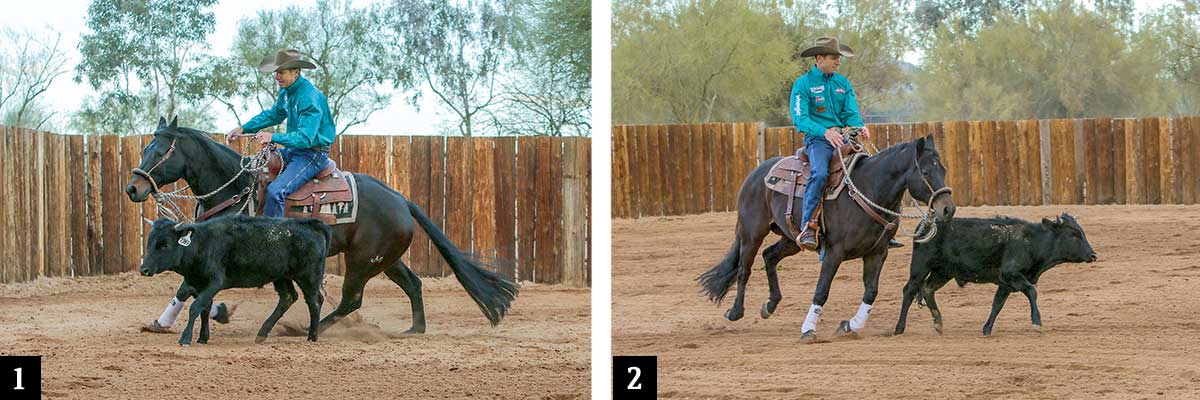When your horse falls out of lead behind, you might be tempted to focus on maneuvering his hind end, which makes sense. But you might not think about the importance of controlling your horse’s shoulders to prevent crossfiring. Without shoulder control, your horse starts to lean toward the cow with his front end and swings his hindquarters out, which sets him up to crossfire, lose balance, and possibly fall. Here, I’ll show two shots on a cow—one correct and one that’s heading off track. I’ll then offer tips to develop hindquarter and shoulder control.

One
I’m in a safe position here, with my horse on his left lead in front and back. My horse’s inside hind leg reaches deeply underneath him, allowing him to drive forward and stay in the correct arc to control the cow. This also allows me to sit balanced in the saddle and support my horse how he needs it. If I have to make a sharp change of direction here to stay with my cow, my horse is balanced and able to fulfill that request.
Two
This situation could turn bad quickly. My horse’s shoulder is closest to the cow—that is, he’s leaning into the cow. This makes it easy for my horse to change leads behind and swing his hindquarters away from the cow and his shoulders into the cow instead of maintaining the desired arc. My horse knows he wants to be with that cow, so it’s natural for his front end to gravitate toward it. But with his shoulders leaning in toward the cow and his hips slipping away, he might lose his ground and fall. Additionally, because my horse is unbalanced, so am I. This combined means it’ll be hard for us to turn or switch sides when I move to circle the cow the opposite direction.

Three
To work on the front and hind ends, I remove the cow from the equation and focus on my horse and his response to my cues for body control. Both parts of this drill can be used as part of your warm-up routine or to correct your horse when he crossfires on a cow. Here and in Photo 4, I work to control my horse as he’s looking inside my circle of travel, where a cow would be. I tip his nose to the inside by lifting my inside rein. My feet drive my horse forward and help control my horse’s hind end.
Four
Here you can see how my left hand lifts and pulls back toward my hip to tip my horse’s nose to look where the cow would be. This also lifts his inside shoulder up and away from the cow. My right hand works in a supporting position and helps control my horse’s hips. If I pull back on my right rein, I can keep my horse’s hips from swinging to the outside. You can see that my outside foot is slightly behind the cinch and drives my horse forward to support my hands’ cues. This puts my horse in a C shape around the circle, which is what I want when we’re circling a cow and keeps his hind end engaged and in lead.

Five
Part two of the exercise helps if your horse wants to lean into the cow. This can also lead to his hindquarters swinging out, which can cause crossfiring. The point is to be able to keep his hind end engaged and in lead while moving his shoulder away from the cow. With steady forward motion, I tip my horse’s nose to counter-bend, so he’s traveling away from his nose. He’s looking at the cow. My direct rein hand controls the degree of the arc, and my indirect rein guides my horse’s shoulders away from the cow (toward the camera).
Six
From this angle, you can see that my outside foot is still placed behind the cinch and drives my horse forward on the counter-arc. It pushes his hips toward his head, supported by my hand position, to make the counter-arc. All of this comes together to keep my horse in lead behind, even when I have to move his shoulders away from the cow.
Brad Barkemeyer, Scottsdale, Arizona, grew up on a ranch in Montana, giving him an appreciation for versatile horses and the Western lifestyle. He now trains working cow horses and coaches amateur riders of all competitive levels, focusing on AQHA and NRCHA events. Learn more on his Facebook page, Barkemeyer Performance Horses.






